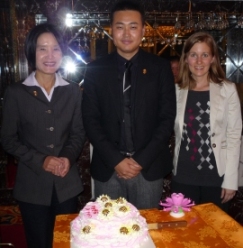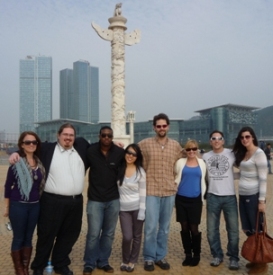Center for Law, Health & Society | News and Events | Center News | 2011 Archive | Gabel and Law Students Take Forensic Research to China Gabel and Law Students Take Forensic Research to China
January 27, 2011
The First Annual World Congress of Forensics - "From Evidence to Verdict" - took place in Dalian, China on October 21-23, 2010. The conference showcased a variety of programs in the field of forensic science and attracted more than 400 participants from around the world. The event brought together forensic medicine experts, toxicologists, forensic scientists, criminologists, and other experts to work as a collective in moving the research and development of forensic science forward.
 Professor Jessica D. Gabel and eight of her Georgia State Law forensic evidence students designed a half-day session of forensic research that they presented at the conference.
Professor Jessica D. Gabel and eight of her Georgia State Law forensic evidence students designed a half-day session of forensic research that they presented at the conference.
In February 2009, the National Academy of Sciences (NAS) released its much anticipated diagnosis of and prescription for the needs of the forensic science community. "The NAS report is an unforgiving indictment of the forensic science used in criminal cases," said Gabel. Among other things, the report recommended standardized procedures, quantification of error rates, and research to establish limits and measures of performance in forensic science.
The research that the law students brought to the global stage in China examined if and how forensic science can meet the challenge set forth by the NAS report. The students researched the evolution of various forensic science disciplines, including advantages, deficiencies, and future utility. They also addressed questions from the audience as to whether forensic evidence such as pattern identification (handwriting, fingerprints, firearms, impressions) can be distilled into quantitative and qualitative norms.
The Georgia State Law group was unique in two ways, according to Gabel. "First, it was the only student group invited to create and present a program at the conference," she said. "And second, it was the only legal panel." The audience and other presenters primarily consisted of scientists, doctors, and technology developers. 
The Georgia State Law program appraised the feasibility and functionality of applying real scientific research to different aspects of forensic evidence. Gabel and her students hope that their initial research might increase financial and political support for crime labs and law enforcement agencies around the world to conduct further quantitative research in the forensic science disciplines.
"The GSU Law panel was one of the most highly attended programs at the conference," said Gabel, "and our students engaged very well with the audience, fielding questions from the world’s top forensic scientists and law enforcement personnel."
The participating students and their subject matters were: Christina Rupp, J.D. 2010 (handwriting); Dean Friedland, J.D. 2010 (firearms); Eric Coffelt, J.D. 2010 (fingerprints); Morgan Leigh, 3L student (forensic anthropology); Allen Bearden, 3L student (digital forensics); Braxton Davis, 3L student (CSI effect and media forensics); Clair Bryan, 2L student (medico-legal death investigation); and Diane Kim, 2L student (arson).